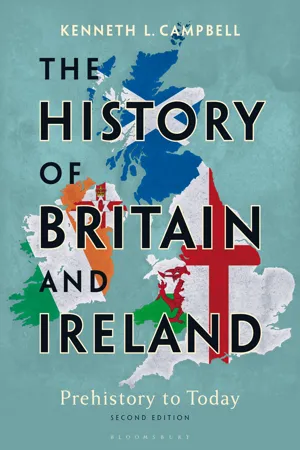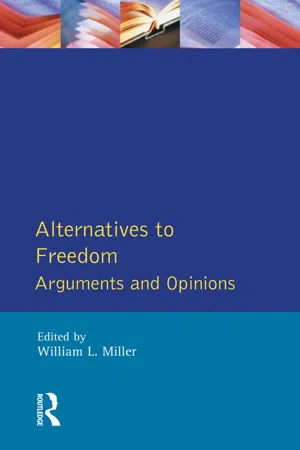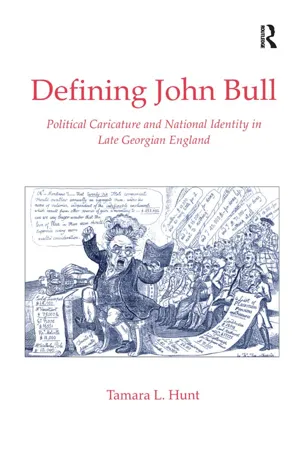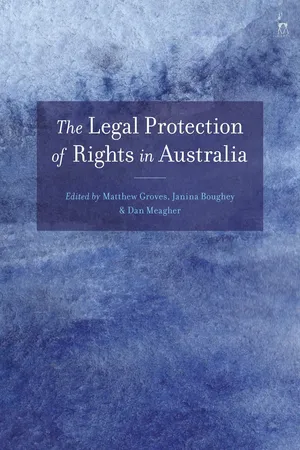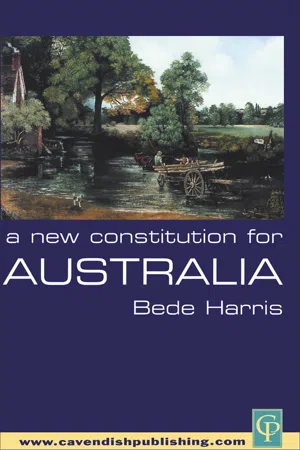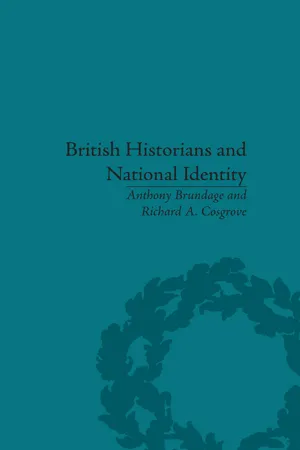History
English Bill of Rights
The English Bill of Rights, passed in 1689, was a landmark document that established the supremacy of Parliament over the monarchy and outlined the rights and liberties of the people. It limited the power of the monarchy, guaranteed free elections, and prohibited cruel and unusual punishment. The Bill of Rights laid the foundation for constitutional monarchy and influenced the development of democratic principles worldwide.
Written by Perlego with AI-assistance
Related key terms
8 Key excerpts on "English Bill of Rights"
- eBook - ePub
The History of Britain and Ireland
Prehistory to Today
- Kenneth L. Campbell(Author)
- 2023(Publication Date)
- Bloomsbury Academic(Publisher)
9 The Struggle for Stability Britain and Ireland in the Aftermath of the Revolutions of the Seventeenth Century, 1690–1746 The English Bill of Rights and the Revolution Settlement in Britain and Ireland The Bill of Rights that followed the Revolution of 1688 provided the basis for the modern relationship between Parliament and the British monarchy. The final version of the Bill of Rights approved by Parliament did not go as far as some had originally intended, as can be seen by a comparison with a previous document called the “Heads of Grievances.” This earlier document asserted demands that would have required new legislation, such as a law prohibiting the interruption of Parliament in the middle of a session. The House of Commons was reluctant to approve any measure that would leave the Revolution open to interpretation as a coup d’état, instead of as a change necessitated by the alleged abdication of James II. The Bill of Rights began by asserting that the king did not have the right to suspend any laws without the consent of Parliament. It then confirmed the illegality of the monarch maintaining a standing army - eBook - ePub
Alternatives to Freedom
Arguments and Opinions
- William L. Miller(Author)
- 2014(Publication Date)
- Routledge(Publisher)
PART ONEFreedom versus Parliament
Passage contains an image CHAPTER 2
Argument: The case for a People’s Bill of Rights 1
LORD JENKINS OF HILLHEADIn the past decade, we have passed through some major centenaries in three of the principal Western countries. 1987 was the 200th anniversary of the United States Constitution, the first definition and enactment of universal and inalienable individual rights. The French followed suit in 1791, although the bicentenial of the Declaration of the Rights of Man was not much celebrated in 1991, mainly because the Revolution which paved the way to it had been so exhaustively – and exhaustingly and expensively – commemorated in July 1989, that there was not much energy or money left for a fresh round. In the meantime, since the American bicentenary, the 300th anniversary of the English Bill of Rights had passed in 1988. This was not much marked either, partly because, in contrast to the French, any retrospective fervour was reserved for the following year and the tercentenary of the so-called Glorious Revolution.But this was not regarded as very glorious in Scotland (still less so in Ireland), and even in England it was well past the heyday of the Whig historians, from Macaulay to his great-nephew G. M. Trevelyan, for whom it was the epitome of good (he even had 1689 as his Cambridge telephone number). 1688 never had this degree of resonance – and rightly so – for the English Bill of Rights was not comparable as a proclamation of the rights of the individual with either the American Constitution or the French Declaration of the Rights of Man. Typically and importantly it was essentially about the rights of Parliament against the Crown and not about the protection of individuals against the Crown, still less against Parliament, except for some vague declaration against arbitrary and excessive punishment.So much for anniversaries. Let me now outline my view of the British tradition of human rights, which I describe as empirical and insufficient. Essentially it is Dicey’s dogma. A. V. Dicey, Professor of Law at Oxford for 30 years and Fellow of All Souls, was the dominant constitutional pundit of late Victorian and Edwardian Britain. He was partnered by Sir William Anson, Warden of All Souls and MP for Oxford University, but Dicey was the more certain and more the fount of doctrine. In 1885 he proclaimed ‘the one fundamental dogma of English constitutional law’ to be ‘the absolute legislative sovereignty or despotism of the Crown in Parliament’: constitutional because it required the enactment of the two Houses of Parliament as well as the formal topping out of the Royal Assent, but despotic - eBook - ePub
- Lois G. Schwoerer(Author)
- 2016(Publication Date)
- University of Virginia Press(Publisher)
TEN · An Individual Right to Arms?The Bill of Rights (1689)T he Revolution of 1688–89 (also known as the Glorious Revolution) marked a climax in the development of England’s domestic gun culture. Over a period of some weeks in January and February 1689, the Convention, a body irregularly elected to settle the crisis, debated the grievances as well as the ancient rights of the nation and wrote one of England’s iconic constitutional documents, the Declaration of Rights, better known in its statutory form as the Bill of Rights. A momentous event, its course briefly described below, the Revolution gave England new monarchs, King William III and Queen Mary II, formerly Prince William and Princess Mary of Orange, and a new kingship in which political authority was shifted to Parliament and new rights were declared.1 One of those new rights, never before claimed, was the right of the individual to arms, which was set out in Article VII of the Declaration and Bill of Rights. That Article read: “That the Subjects which are Protestants may have Armes for their defence Suitable to their Condition and as allowed by law?” The intention of the men who drafted Article VII and the meaning of its language are at issue today. This chapter attends to these matters.On 29 January 1689, Anthony Cary, Lord Falkland, a Tory member of the House of Commons of the Convention, rose to address the assembly, which was beginning a second day of serious work. In a short speech filled with radical implications, Falkland urged the assembly not to think about filling the throne until they had decided “what Power . . . to give the Crown . . . and what not.” The Prince of Orange has rescued us from Popery, he said, and now we have the opportunity to “secure ourselves from Arbitrary Government.” Pressing his point later in debate, Falkland urged the need “to change things as well as hands,” to “lay the foundations” of the government anew.2 - eBook - ePub
Defining John Bull
Political Caricature and National Identity in Late Georgian England
- Tamara L. Hunt(Author)
- 2017(Publication Date)
- Routledge(Publisher)
5 The Rights of Englishmen The concept of the ‘rights of Englishmen’ was almost as amorphous as the figure of John Bull, which became more apparent as calls for political reform mounted in late Georgian England. Central to this debate were questions about the rights of citizens to complain about government oppression and to demand redress. Since the notion of a ‘loyal opposition’ within government was itself very recent, there was virtually no formal structure for extra-Parliamentary debate on – and opposition to – unpopular government measures. For example, the Bill of Rights plainly stated that ‘it is the right of subjects to petition the King,’ but this right was not as straightforward as it appeared. Did this also authorize petitions to Parliament, and, if so, could groups organize to draw up petitions promoting particular political reforms? Some argued that such political activism was illegal, since the Bill of Rights also declared that Parliamentary debates or proceedings ‘ought not to be impeached or questioned in any court or place out of parliament,’ and meetings held to complain about Parliamentary policies certainly seemed to fall under the heading of questioning the legislature’s actions ‘out of parliament.’ 1 Even if Parliament and the government ultimately agreed that the public had some right to discuss official policy, they were under no obligation to act on petitions or to treat as legitimate the activities of various political groups organized to obtain political reform. 2 The public faced a similar quandary; as political debate became more polarized, the complaints and activism of individuals and groups had to be evaluated to determine if they were legitimate, e.g., within the existing structure of the English constitution - eBook - ePub
- Matthew Groves, Janina Boughey, Dan Meagher(Authors)
- 2019(Publication Date)
- Hart Publishing(Publisher)
19 A Common Law Bill of RightsDAN MEAGHER*I.IntroductionThis chapter will outline the historical, political and jurisprudential developments in Australia which have led to the establishment of what has been called ‘a common law bill of rights’.1 In order to do so, Part II will interrogate and contextualise the foundational decision of the framers of the Australian Constitution to reject the need for and wisdom of a constitutional bill of rights. Part III will outline briefly those international and domestic developments (especially since World War II) which triggered the rise of fundamental rights as a core legal concern; and a series of (rights-hostile) legislative developments will be traced to explain how and why a new judicial rights consciousness has emerged in Australia. Part IV will then explain the manner in which a common law bill of rights has been judicially established. This will include an account of what rights, freedoms and principles fall within its purview and why; and how the courts seek to protect from them legislative encroachment. Then Part V will explore those controversies and questions which attend the establishment of the common law bill of rights in Australia. Finally, in Part VI , the manner in which its future development might proceed will be considered.II.HistoryIt is commonplace to state, often in pejorative terms, that Australia is the only Western liberal democracy without a constitutional or statutory bill of rights.2 And in this regard Australia is often unfavourably compared to other Commonwealth nations such as Canada, New Zealand and the UK where formal rights guarantees now form an important part of their constitutional architecture.3 Yet the framers of the Australian Constitution were well aware of the issue. The original 1891 draft Constitution, largely the work of the Tasmanian poet, philosopher, engineer, judge, politician and fierce republican Andrew Inglis Clark,4 - eBook - ePub
- Bede Harris(Author)
- 2013(Publication Date)
- Routledge-Cavendish(Publisher)
contra bonos mores. In Bill of Rights cases, the courts will simply balance competing interests using the test the Bill of Rights contains permitting the limitation of rights. In the example of employer-imposed restrictions on freedom of expression, one might expect that the courts would come to a different conclusion in relation to a person employed by a political party than it would in the case of a person employed as an accounts manager of a department store. In the latter case, the restriction is irrelevant to the job and thus unreasonable, whereas in the former, the nature of the job is such that some direction by the employer in relation to what employees might say would not be unexpected.2.7 PROTECTING A BILL OF RIGHTS THROUGH ENTRENCHMENT
A crucial issue in assessing the usefulness of any Bill of Rights is the extent to which it is protected from legislative override. Although many jurisdictions have a ‘Bill of Rights’, documents sharing this generic title may have very different legal effects. This section focuses on the extent to which Bills of Rights provide an effective restraint on the legislature. Not all Bills of Rights do so, as the following examples show.The New Zealand Bill of Rights Act 1990 affirms the existence of certain rights, many of which are similar to those found in the Canadian Charter of Rights and Freedoms. However, the Act has the status of ordinary legislation, and can therefore be overridden by Parliament. The Act does attempt to impose a political cost on a government seeking to legislate contrary to its provisions, in that s 7 of the Act obliges the Attorney-General to inform Parliament when proposed bills are inconsistent with the rights protected by the Act. However, compliance with this provision does not form part of the legislative process, and so non-compliance does not invalidate offending legislation.253 - Frederick Cowell(Author)
- 2017(Publication Date)
- Routledge(Publisher)
52The myth of the UK’s “liberty-drenched ancient past” is sufficiently obscure to enable May to invoke it in the cause of rebalancing rights protections in favour of Parliament’s supremacy.53 Invocations of the Magna Carta often serve as a crypto-heritage by which to justify weakening domestic human rights arrangements and minimising the role of pan-European protections.When David Cameron first mooted the idea of a British Bill of Rights the Labour government scoffed that human rights could not be better reconciled with the UK’s principle of parliamentary sovereignty than under the HRA’s mechanisms.54 What Labour ministers did not appreciate is that the Conservative leadership would quietly abandon Cameron’s early suggestions of an “entrenching” bill, in favour of legislation which would sustain the doctrine of parliamentary sovereignty.55 By the time the Conservative Party came to develop its ideas for a bill of rights ahead of the 2015 General Election, it was adamant that “[i]n all matters related to our international commitments, Parliament is sovereign”.56 As Lord Chancellor Michael Gove was even magnanimous enough to recognise that in legislating “[w]e need to ensure that we uphold parliamentary sovereignty, which, to be fair, the Human Rights Act affirms, and make Parliament’s view clear on these issues”.57 Far from enhancing the limited powers the HRA gave the courts with regard to primary legislation, the Conservatives’ British Bill of Rights would “[p]revent our laws from being effectively re-written through ‘interpretation’ ”.58 The Magna Carta is therefore the ideal avatar for the Conservatives’ proposals as it is the nearest thing to an “irrepealable ‘fundamental statute’ that England has ever had”.59 Nonetheless, as the courts have consistently affirmed, this reverence has not made it immune “from development or improvement”, to the extent that very little of the charter remains on the statute book.60 The Conservatives’ proposals envisage removing the teeth from existing HRA protections, all the while wrapping their reforms under a title of Bill of Rights, with its implication of strike-down powers.61- eBook - ePub
British Historians and National Identity
From Hume to Churchill
- Anthony Leon Brundage(Author)
- 2015(Publication Date)
- Routledge(Publisher)
61 The year 1688 decided the previous five centuries of conflict between crown and monarchy forever after in Parliament’s favour.Just as important to this historic outcome was the succeeding regime of William III (1688–1702): ‘His reign is no doubt one of the most important in our constitutional history, both on account of its general character … and of those beneficial alterations in our law to which it gave rise’.62 This legacy included such important statutes as the Bill of Rights (1689), the Triennial Act (1694) and the Act of Settlement (1701). William III, Hallam explained, demonstrated a capacity for public affairs far greater than his Stuart predecessors and understood the spirit of the constitution much better. The legislative consequences of the Glorious Revolution had William’s support; he possessed no interest in a counter-revolution. It took a foreigner to perceive the principles that ‘settled’ the constitution.In the aftermath of the Glorious Revolution and its subsequent influence, civil society developed in a manner that made England a paragon in European affairs. Continental countries adhered to theories of absolutism, but England remained committed to its constitution of liberty. When the Constitutional History appeared in 1827, Hallam asserted, European nations admired England precisely because the sovereignty of Parliament guaranteed the appropriate balance between order and liberty: ‘The pulse of Europe beats accordingly to the tone of our parliament’.63 This leadership has occurred because ‘Parliament served the Protestant and national unfolding of the country and disclosed the inner meaning of its history’.64 Constitutional superiority provided the most important distinction that the English people possessed, the genius that placed the nation above all others.Hallam no longer has a place in the gallery of nineteenth-century historians whose work is still discussed by contemporary historians. John Kenyon wrote, however, that ‘this was a remarkable book, no longer appreciated as it ought to be’.65 Hallam went out of fashion in the late nineteenth century because he did not fit the profile of the scholar scouring the archives in a quest for new knowledge on the basis of hitherto undiscovered sources, for he relied on printed documents. He rejected the philosophical history of Hume and the partisan work of Lingard. Nor did he agree with the romantic historians of his era who sought to dramatize English history in order to entertain the public. He wrote for the educated individual who would appreciate the lessons he propounded. As Peter Clark has noted: ‘His neglect is to be regretted’.66
Index pages curate the most relevant extracts from our library of academic textbooks. They’ve been created using an in-house natural language model (NLM), each adding context and meaning to key research topics.
